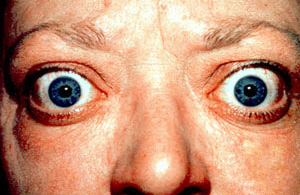Graves' ophthalmopathy
| Graves ophthalmopathy | |
|---|---|
 |
|
| Bulging eyes and lid retraction from Graves' Disease | |
| Classification and external resources | |
| Specialty | ophthalmology |
| ICD-10 | H06.2* |
| ICD-9-CM | 242.90 |
| DiseasesDB | 5419 |
| eMedicine | oph/237 ent/169 neuro/476 radio/485 |
| MeSH | D049970 |
Graves' ophthalmopathy (also known as thyroid eye disease (TED), dysthyroid/thyroid-associated orbitopathy (TAO), Graves' orbitopathy) is an autoimmune inflammatory disorder affecting the orbit around the eye, characterized by upper eyelid retraction, lid lag, swelling, redness (erythema), conjunctivitis, and bulging eyes (exopthalmos).
It is part of a systemic process with variable expression in the eyes, thyroid, and skin, caused by autoantibodies that bind to tissues in those organs, and, in general, occurs with hyperthyroidism. The most common form of hyperthyroidism is Graves' disease. About 10% of cases do not have Graves' disease, but do have autoantibodies.
The autoantibodies target the fibroblasts in the eye muscles, and those fibroblasts can differentiate into fat cells (adipocytes). Fat cells and muscles expand and become inflamed. Veins become compressed, and are unable to drain fluid, causing edema.
Annual incidence is 16/100,000 in women, 3/100,000 in men. About 3-5% have severe disease with intense pain, and sight-threatening corneal ulceration or compression of the optic nerve. Cigarette smoking, which is associated with many autoimmune diseases, raises the incidence 7.7-fold.
Mild disease will often resolve and merely requires measures to reduce discomfort and dryness, such as artificial tears and smoking cessation if possible. Severe cases are a medical emergency, and are treated with glucocorticoids (steroids), and sometimes ciclosporin. Many anti-inflammatory biological mediators, such as infliximab, etanercept, and anakinra are being tried, but there are no randomized controlled trials demonstrating effectiveness.
...
Wikipedia
